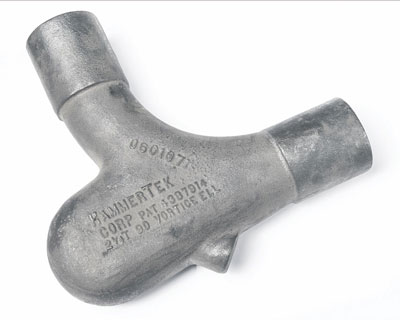Sealmaster of Allentown, Pa. packages and ships pavement maintenance products to 50-plus countries through more than 100 distribution centers in North America and Asia. Its headquarters plant uses silica sand as a filler to improve durability and add skid resistance to pavement sealers. The 60 mesh (250 micron) sand arrives by pneumatic truck trailer equipped with a 1,000-cfm blower. A length of 4-in. flexible hose connects the bulk tanker to the silo’s 4-in. schedule 40 pipe, which is routed 20 feet vertically, 7 feet horizontally and then downward to feed the silo, requiring two elbows.


Sealmaster has been offloading sand at Allentown for about six years, but according to Plant Manager Curt Stein, “We had problems since day one. As soon as it began to turn, the sand would erode or eat through the sweep elbow and eventually just shoot out the side. We went to a heavier elbow, but that didn’t work. The sand just ate through it within weeks. Then we went to a concrete-reinforced elbow. Within a couple of months, the sand ate right through the inner steel lining, through the concrete, through the outer steel lining and shot out again.”
The recurring problem was frustrating, expensive and difficult, as the repairs had to be made 25 feet in the air, he adds.


Since the elbows were welded in place, replacing them incurred significant labor and downtime. “It took three people—somebody on the ground to monitor safety, somebody in the air, and someone operating a lift truck. In the early days, because it was a direct replacement, we’d have to cut off the sweep elbow and weld in the replacement. The guy in the air would also have to handle the welding equipment,” Stein recalls. “Later, we used bolt-on flanges thinking if we’ve got to replace the elbow, let’s make it easier. We did that, but every couple of months we’d have to remove the elbow and bolt on a new one, which still incurred downtime and labor. That’s when I contacted HammerTek.”
Unlike conventional elbows that rely on material impact to change direction, the manufacturer’s Smart Elbow design employs a spherical chamber that protrudes partially beyond the desired 90° or 45° pathway, causing a ball of material suspended in air to rotate. Since the ball rotates in the same direction as the airstream that powers it, incoming material is cushioned by the ball’s rotation and gently deflected around the bend. The HammerTek deflection elbows prevent sand from impacting the wall, which has eliminated silo pipe connection failure at the Sealmaster flagship. Blow-outs, which previously shut the conveying system down every few months, have not occurred in years.
“In terms of payback, you have the direct expense of materials, your labor and the downtime, but more importantly, you don’t have people working 25 feet off the ground handling heavy steel pipes,” Stein explains. “I have another pneumatic system for powdered clay, and if those elbows ever wear through, I will employ the same solution.” — HammerTek Corp., Bethlehem, Pa.; 610/814-2273; www.hammertek.com